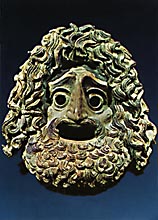

|
The work by Aristotle which has come down to us as his Poetics was probably written at some time between 347 and 342 B.C. and then underwent detailed revision. This revision may have been by Aristotle himself, or it may have been by a pupil of his. There is no question of a systematized aesthetics, either here or anywhere else in Aristotle. What we have before us is a specimen of the theory of literature. In it are many indirect answers to views expressed by Plato; and it was enormously influential in the centuries that followed. In the Poetics, as elsewhere, Aristotle applied his characteristic methodology - classification. He was thus able (unlike Plato) to look at poetry independently of ethics and politics. For him, it was to be ranked with the imitative arts. The latter fell into two categories: "imitations" of visual representations through shape and colour; and "imitations" of human actions through the spoken word, music, and the dance. Oikeia hedone and katharsis are two key concepts in Aristotle's view. |
 |

In order to see how poetry works, Aristotle looks for the purpose behind it - its telos, in other words its final cause. Simultaneously, he advances two fundamental propositions. These are:
that mimesis is - like rhythm and tune - instinctive in the human animal; and
that when one recognizes "imitation" this engenders pleasure (even where the subject imitated is not pleasant), because the viewer is learning to recognize. This argument is a rebuttal of Plato's position that art has no cognitive value.

The term katharsis comes either from the practice of medicine and healing, or from religious ritual, and its interpretation is highly controversial. It is widely accepted today that by provoking emotion tragedy has a therapeutic effect on the spiritual well-being of its public, and that this is what the psychological function of katharsis consists of.
Lastly, one further difference between Aristotle and his master Plato - his view that works of art call not for moral but simply for aesthetic censorship. Why? Because in Aristotle's view of art, a feeling for justice and morality coincides with aesthetic wholeness.
 |
 |
|
| |
|||
| |||